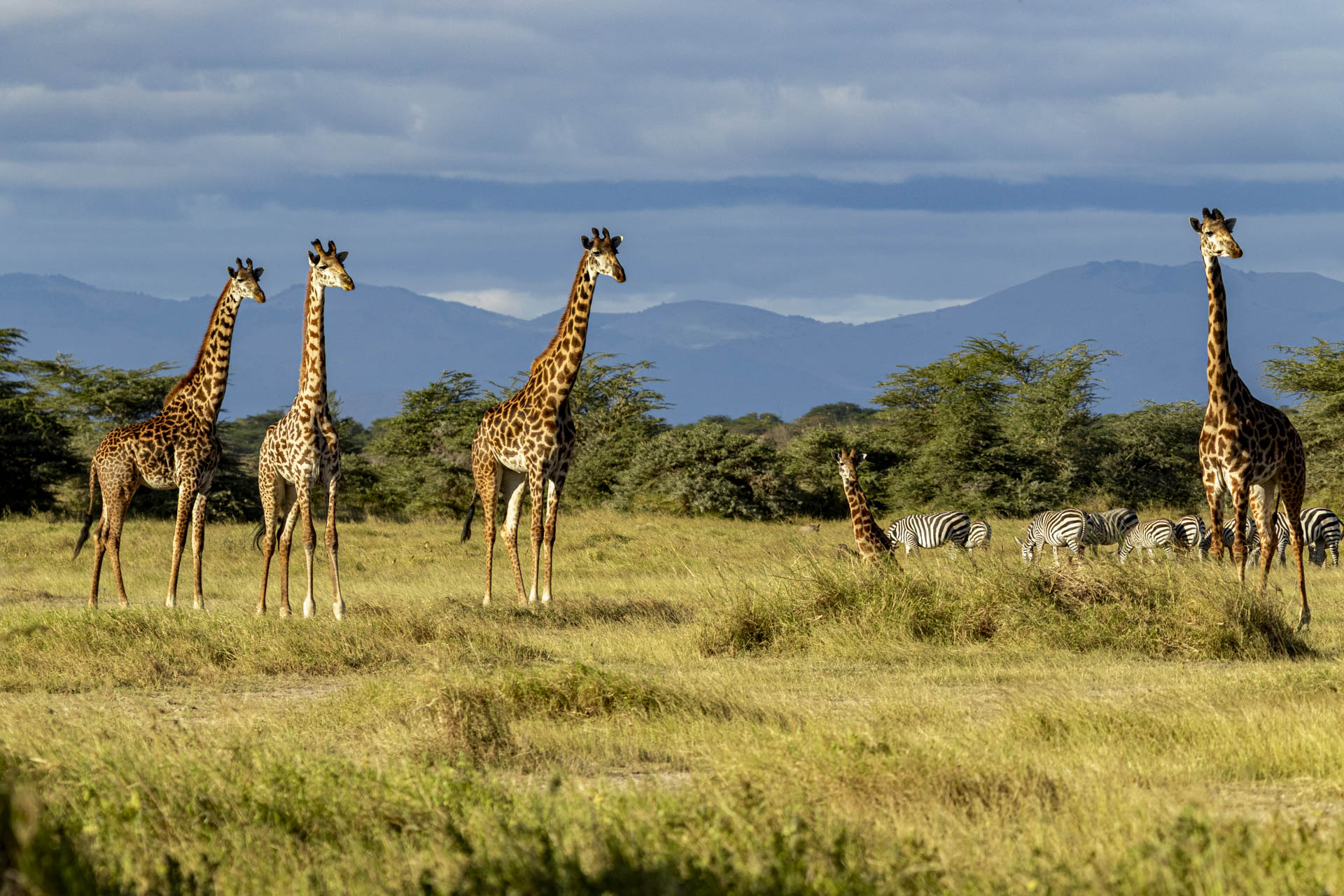The highlight of the week, both for our guests and The Angama Photographic Studio, was an unforgettable encounter with a special resident. An elusive young female leopard, who has become a legend around the lodge, was finally caught on camera.
Guest Sameer, accompanied by Guide Kenneth, captured a shot of her while heading back to Angama Mara after sunset. As they passed near the barbecue area, they noticed movement. There she was, graceful and alert, crouching low to the ground, her sleek body blending into the fading light.
She paused near a bush, sitting quietly, watching them with calm curiosity. Although cautious, she didn’t seem too shy, perhaps because she’s grown used to the quiet presence of people in her territory.
Over the past weeks, she’s been seen moving in and out of the lodge grounds, carefully navigating her way down the escarpment and returning under the cover of darkness.
The following day, as the first light of dawn cracked through the horizon, we stumbled upon a southern ground hornbill as it had snapped up a writhing snake from the undergrowth, tossing it into the air before swallowing it whole with brutal elegance.
True to their name, ground hornbills rarely take to the skies unless necessary. Instead, they patrol the land like feathered sentinels in slow, deliberate steps, sifting through leaf litter, fallen logs, and tall grass for insects, reptiles, or whatever unfortunate creature crosses their path.
My Photographic Studio colleague Japheth Supeyo saw something heartbreaking and deeply inspiring: a young elephant with only half a trunk. We suspect it lost the rest early in life, possibly to a predator, yet somehow, against all odds, it survived.
What struck us most was how seamlessly it had adapted: lowering its head drastically to drink or forage, so that its massive shoulders became visible from the front, a posture rarely seen in elephants. This juvenile survivor is a testament to resilience in the wild, where every disadvantage can mean the difference between life and death.
When a carcass hits the ground in the savannah, a fierce hierarchy of vultures descends in a drama of survival. The lappet-faced vulture leads the charge with its massive, hooked bill ripping open tough hides and thick skin, refusing to yield as it lays bare the feast within, literally the 'gatekeeper’ of the carcass.
Next in line, the African white-backed and Rüppell’s griffon vultures sweep in, their serrated tongues and medium-sized beaks expertly stripping away the soft flesh and organs, devouring the bulk of the meat in swift, social feasts. Finally, as the giants retreat, sated, the diminutive hooded vultures make their move, dubbed the 'savannah surgeons’.
They delicately extract every remaining scrap of flesh from bones, their tiny beaks operating with precision on the carcass’s very edges. Each species patiently waits its turn, a survival ritual etched into their instincts, ensuring nothing goes to waste and every species, from the powerful to the petite, earns its keep in the wild.
While on an early game drive in the Mara Triangle, we saw the Owino pride members doing something often unseen: resting lazily on slanted, low-hanging branches. It wasn’t just a random climb. These lions had cleverly found the perfect perch to escape the relentless swarm of flies that usually torment them during their naps.
Above the buzzing chaos, they sprawled across the bark as if the trees had been designed just for them. From their vantage point, they found peace and could keep an eye on their surroundings while alert, even in slumber, to the shifting rhythm of the savannah.
Later that evening, Guide Robert spotted the Oloololo pride in the trees, echoing the same behaviour. It was clear this wasn’t a coincidence; it is an adaptation. The branches offer shade and a cool breeze that rustles their manes as they rest.
The morning air was thick with the safari suspense as we rolled into the golden light of dawn, and there they were, three sub-adult nomad males walking the road with a restless urgency. Their movements were deliberate but uneasy, each step betraying a story untold. They weren't just wandering; they were fleeing or approaching something that demanded caution, maybe even blood. Behind them lay the territory of Muuaji and the Owino male rulers of the northeast Mara Triangle, each with pride to protect and borders to defend.
These nomads were deep in enemy ground, ghosts with manes not yet full, threading the edge between exile and ambition. Later that week, reports placed them near the dense riverine forest by the Mara River, the kind of place lions retreat to not for rest but for war councils, perhaps plotting a return to the Greater Mara Reserve or preparing to stake their claim here, even if it means war. — Rio Marvin
The resident lions of Kimana Sanctuary bring the night to life with their deep, resonant calls. They are primarily nocturnal hunters and spend most of the day resting, often tucked away in the tall grasses or shaded beneath the flat-topped Tortilis acacias that dot the landscape. Because of this, they’re easy to spot during the early morning or late evening hours.
On one evening drive, we encountered Noltulali — a lioness last seen heavily pregnant just two weeks ago. Now noticeably slimmer, it’s likely she has given birth — an encouraging sign that new cubs may soon be seen in the area.
Driven by the demands of nursing, Noltulali was clearly in hunting mode. However, the sharp eyes of nearby giraffes spotted her, forcing her to abandon her halfhearted chase. With an abundance of warthogs in the Sanctuary, we're confident she made a successful kill under the cover of night.

Driving through Kimana Sanctuary and Amboseli National Park, there’s a noticeable influx of herbivores, particularly zebras and wildebeest. This seasonal movement peaks in June, as animals search for fresh grazing and reliable water sources like the rivers in the Sanctuary and the swamps of Amboseli. These migrating wildebeest belong to localised populations that move within the greater Amboseli ecosystem, drawn to areas with permanent water after dry spells elsewhere.
The surge in wildebeest numbers also signals the start of the rutting season, which follows the calving period. This is a dynamic and energetic time marked by heightened mating activity. Male wildebeest establish short-term territories they compete through loud grunts, dramatic chases, and physical battles in the hope of winning over receptive females.
Every day in Amboseli National Park, elephant herds cross the open plains in a mesmerising procession with the majestic Mount Kilimanjaro towering in the background. These gentle giants walk to the lush swamps that provide them with essential water and nourishment, during the dry season. The herds are led by matriach often with calves in tow and sometimes a massive bull in the midst.
The Amboseli ecosystem is a haven for bird enthusiasts, boasting over 400 recorded bird species thriving across its varied habitats. From open grasslands and acacia woodlands to seasonal marshes and swamps fed by Kilimanjaro’s underground springs, the diversity of environments supports an incredible array of both resident and migratory birds.
One fascinating sighting this week was the African swamphen, native to sub-Saharan Africa and the Nile Valley. Swamphens are perfectly adapted to wetlands. With their long toes, they can easily walk on floating vegetation, reed beds, and soft, muddy ground.
Formerly known as the red-billed wood hoopoe, the green woodhoopoe can be seen close to the lodge. It is a metallic-green-black bird with red feet and a long, decurved, red-orange bill. It was quite a challenge to identify as they are almost identical to Grant’s and Violet woodhoopoes.
The Cape teal is one of the few dabbling duck species that can dive and swim underwater with their wings closed, similar to true diving ducks. Typically, dabbling ducks dive with their wings open. This species is easily distinguishable from other ducks by its distinctive pale grey plumage and unique pink bill.
A common bird to see is the Egyptian goose. We came across this one goose bathing on a hot day. Birds shower or bathe to maintain healthy feathers and regulate body temperature.
The sharp beak of a heron is a specialised tool perfectly adapted for its feeding behaviour. Herons are primarily fish-eaters, and their long, pointed beaks function like a spear, allowing them to strike quickly and accurately at fish or other aquatic prey. They are often seen standing still in shallow water, and when prey comes closer, they thrust their beak like a harpoon, either spearing the prey or grasping it firmly. — Robert Sayialel
Filed under: This Week at Angama
Subscribe for Weekly Stories
Comments (0):

Weddings in the Mara